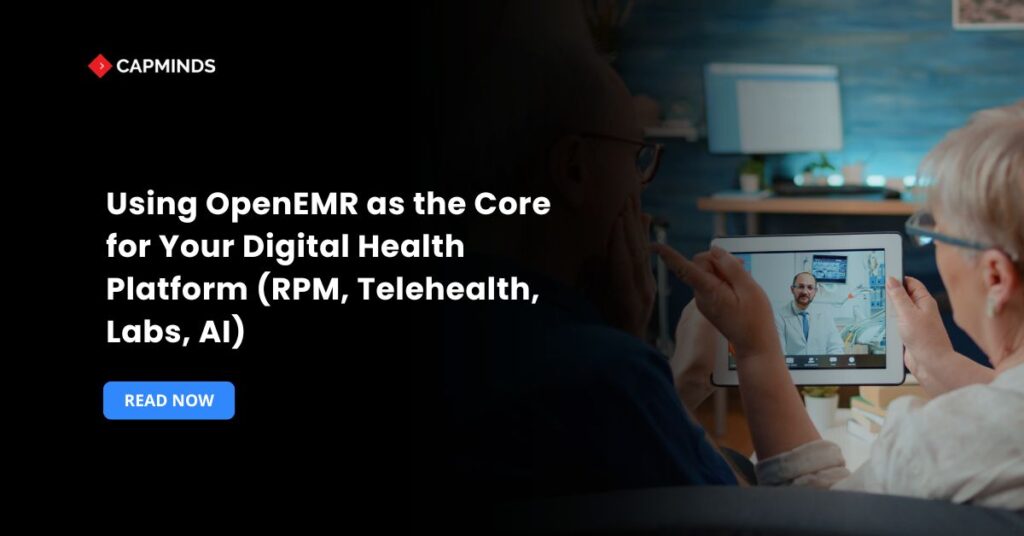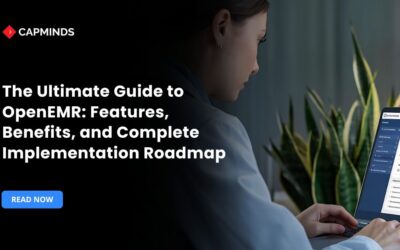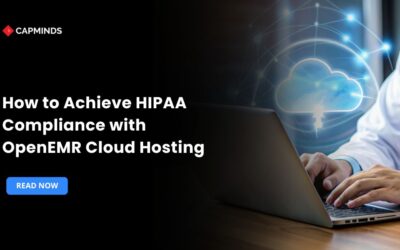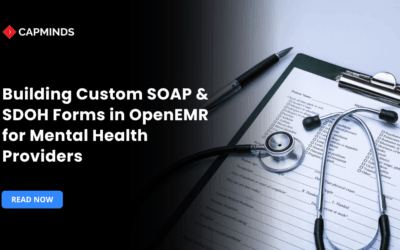Using OpenEMR as the Core for Your Digital Health Platform (RPM, Telehealth, Labs, AI)
The healthcare sector industry is rapidly digitizing, and providers and IT innovators are looking for strong yet cost-effective solutions to create scalable, compliant, and interoperable platforms. OpenEMR is a free open-source system that can serve as the foundation for new digital health platforms.
In this blog, you’ll learn how OpenEMR serves as the foundation for integrated solutions such as RPM, telehealth, lab integration, and AI-driven insights that help providers to generate revenue and drive innovation.
Why choose OpenEMR as the core?
OpenEMR is more than just an EHR; it’s an open-source, configurable, and modular solution with robust APIs and compliance features. When implemented properly, it may shorten time-to-market and reduce development costs for digital health solutions.
Key Advantages
- Open-source, no licensing costs, and complete control over codebase modification.
- Verifies compliance with US healthcare standards such as HIPAA and MACRA.
- The built-in modules and extensive API structure allow for smooth integration and are highly customizable.
- A worldwide developer and user community is constantly improving the platform.
- Supports FHIR, HL7, CCD, Direct Messaging, and other interoperability standard protocols.
Advantages of an Integrated Platform
Streamlined Clinical Workflow
Embedding RPM data, telehealth calls, lab orders, and AI technologies directly into the EMR eliminates context switching and enhances productivity.
Enhanced Patient Experience
Patients may access telehealth, lab results, device readings, and AI-powered guidance all from one platform.
Faster ROI and Scalability
Without license costs, ROI is driven by productivity improvements, patient engagement, and chargeable services like as RPM and telehealth.
How OpenEMR Supports Modern Digital Health Components
1. Remote Patient Monitoring
RPM systems are based on real-time data from wearables and medical devices. This data may be ingested, stored, and shown via OpenEMR’s patient dashboards or third-party analytics integration.
- Bluetooth-enabled blood pressure monitors, glucose meters, and oximeters.
- Real-time patient vital signs recording, alerts for abnormal readings.
- Tracks the chronic care treatment plans for chronic patients.
2. Telehealth
OpenEMR’s patient portal and appointment modules can be integrated with video conferencing solutions to build a HIPAA-compliant telehealth system.
- Secure video consultations using Zoom or Twilio interfaces.
- ePrescription and digital notes are provided after consultation.
- An integrated calendar with reminders is sent via SMS or Email.
- Reimbursement codes for virtual consultations.
3. Lab and Diagnostic Integration
Digital health systems frequently demand efficient lab order processing and results distribution. OpenEMR’s support for HL7 and LOINC makes this easier.
- Submit lab orders directly to LabCorp, Quest, etc.
- Automatic synchronization of test findings with patient records
- Customized warnings for crucial values can be set.
- Clinical decision support for lab interpretation.
4. AI & Predictive Analytics
OpenEMR may function as a data repository for your AI engine. Using APIs to integrate machine learning models, prediction tools may be created on top of structured clinical data.
- Reduces Readmission Risk Scoring.
- Population Health Insights.
- Medication Adherence Analysis.
- Using NLP on medical notes to predict diagnoses.
Related: AI Chatbots for Healthcare: A Smarter Way to Support Patients & Providers
Implementation Strategy: Creating Your Platform Using OpenEMR
To successfully leverage OpenEMR as the foundation of your digital health solution, follow this tiered roadmap:
1. Planning and Architecture
- Identify the essential modules such as appointments, billing, and encounters.
- Determine the interoperability needs, such as FHIR, HL7, and SSO.
- Choose the hosting type, like On-premise, cloud-based, or hybrid methods.
2. Custom Development and Integrations
- Customize the UI/UX to match your platform’s brand.
- Integrate device data streams for RPM.
- Implement secure video solutions for telemedicine.
- Create or combine AI APIs with current patient datasets.
To eliminate context transitions, use built-in telehealth workflows like a completely integrated calendar, video, and documentation.
Integrate RPM data flow with OpenEMR, automating vital sign imports and alerts for physicians. Lab orders via OpenEMR to laboratories, with findings sent immediately into patient records.
3. Compliance and Security
- Perform HIPAA, HITECH, and GDPR checks for data security and privacy.
- Set user access roles and audit logs to ensure security.
- Use data encryption for all data communications.
Choose cloud or on-premises hosting with redundancy and partner with vendors for hosting and support.
4. Testing and Deployment
- Test with fake and real-world data.
- Conduct security penetration testing.
- Train employees and onboard providers.
Begin with a pilot test, like a telehealth module and portal in one department, and then add RPM helpers later. Monitor KPIs such as patient volume, no-shows, time savings, patient satisfaction, and readmission rates.
5. Workflow & Staff Training
- Define explicit clinical and administrative workflows.
- Scheduling leads to telehealth, encounters, lab/RPM orders, and automated chart input.
- Educate providers and front-desk workers about platform differences and efficiency.
Best Practices for Integration
|
Areas |
Best Practice |
| Standardization | Use HL7/FHIR for device and lab data, ensuring organized, codified records. |
| Workflow Design | Map all steps, from virtual check-in to clinical notes, with little manual entry of information. |
| Training & Support | Provide extensive provider and administrator training and collaborate with approved OpenEMR suppliers. |
| Patient Education | Provide instructions and portal walkthroughs; use screen-sharing and invite options during telehealth. |
| Continuous Improvement | Analyze result data, iterate features, and enhance workflows easily. |
OpenEMR is a robust and adaptable basis for any digital health platform that seeks to provide full capabilities such as telemedicine, RPM, lab integration, and AI.
With the correct design and best practices, you can build a compliant, scalable, and cost-effective solution that attracts a lot of attention from providers and tech partners.
Related: Achieving Interoperability at Scale: HL7, FHIR, and API Integrations with OpenEMR
CapMinds OpenEMR Customization and Integration Service
CapMinds OpenEMR equips clinicians with the best features and ways to integrate. It makes their workflows more efficient and filtered.
The integrated features will allow them to combine the ability of patient record management with conceptual and concurrent reminders.
This enhances the process of decision-making and improves patient care and quality.
- At CapMinds, OpenEMR custom solutions are developed with much care and accuracy to match the special practice needs.
- It will be low-cost and the perfect budget solution for your practice’s long-term future.
- CapMinds OpenEMR prioritizes secure data management & ensures compliance with industry regulations, offering healthcare providers peace of mind.
Get the best technologies and HIPAA-compliant and efficient OpenEMR from CapMinds that can be tailored to fit your practice.
Our OpenEMR services facilitate a Modern User Interface (UI), customization, production support, and training. They also facilitate billing, reporting, specialty enhancements, clearing house integrations, e-prescribing, and cloud services.
“Get the most experienced, proven, and perfect professional support for your OpenEMR.”




